As with all their efforts to provide me weekend breaks from the
combination of tension and drudgery at the hospital, I appreciated their
kindness more than I can say and gratefully accepted. To get to the ponds we walked down a paved pathway through a most attractive patch of urban forest. Here I found a few butterflies, including this Common Five Ring (Ypthima baldus newboldi) - and if you are as confused as I trying to tell Singapore's various Ypthima species, here is a handy and most useful guide,
This is another familar Singapore butterfly, the Brown or Chocolate Pansy (Junonia hedonia ida). Confusingly, these names are also applied to another local butterfly, Junonia iphita, which should more correctly be called the Chocolate Soldier. This is the one with eyespots.
A Common Tailorbird ( Orthotomus sutorius) - a common species here, but one I don 't often see, as for some reason it is absent from Borneo - scolded us from the undergrowth as we passed. This, for Jungle Book fans, is the scolding tailorbird of Kipling's Rikki-Tikki-Tavi.
On our way through the park we spotted a pair of highly cooperative Laced Woodpeckers (Picus vittatus), the only "green" woodpecker resident in Singapore.
When the pair pose together, it is easy to see the difference between the red-crowned male and his more sombre mate.
When the pair pose together, it is easy to see the difference between the red-crowned male and his more sombre mate.
A Plantain Squirrel (Callosciurus notatus) eyed us as we continued down to the ponds.
We finally reached the larger of the two ponds, but it took a bit of walking to reach the one part that gave direct access to its edge. Here, though, I found enough odonate action among the sedges and other water plants to keep me occupied for some time.
We finally reached the larger of the two ponds, but it took a bit of walking to reach the one part that gave direct access to its edge. Here, though, I found enough odonate action among the sedges and other water plants to keep me occupied for some time.
I only found three species of dragonfly, and one of them - the late-afternoon specialist Thylomis tillarga - defeated all my attempts to photograph it. Two individuals repeatedly coursed back and forth along the shore, frequently challenging each other or chasing other dragonflies, but refused to either perch or hover for more than a couple of seconds. I had far better luck with the other two, and in particular with the spectacular Crocothemis servilia, the Scarlet Percher (known as the Scarlet Skimmer in North America, where it has been introduced). Perch it did, and frequently enough to keep any photographic duffer happy.
This individual is carrying an unwanted passenger - that spiky brown lump on the top of its thorax is apparently a parasite of some sort.
This individual is carrying an unwanted passenger - that spiky brown lump on the top of its thorax is apparently a parasite of some sort.
Less startling, but equally photogenic, was the widespread Brachydiplax chalybea. The two seemed to be the only dragonfly species around in any numbers, apart from the two patrolling Tholymis...
I was busy trying to photograph dragonflies when Chris excitedly called my attention to a "beautiful bird". I wasn't sure what to expect - but I certainly got a surprise.
It was, of all things, a White-crested Laughingthrush (Garrulax leucolophus) - a bird that, by rights, should have been no closer to Singapore than northern Myanmar. I had totally forgotten that this popular cage bird, first recorded here around 1995, was now an established exotic. Singapore has, in fact, rather more than its share of exotics, as might be expected from a heavily populated island state that was once (and to a lesser extent still is) a major hub for the international wildlife trade.
We soon found a family group of laughingthrushes, hopping around with excited cries practically at our feet. They had found something far more worthy if their attention than mere humans - a substantial and ferocious-looking centipede, obviously a delicacy to be pursued with some care. The troupe seemed to treat it as the laughingthrush equivalent of a hot potato.
The fuss over the centipede attracted a White-breasted Waterhen (Amaurornis phoenicurus), obviously intrigued by the racket...
After repeatedly picking it up, dropping it and tossing it about, one of the laughingthrushes finally flew off into the undergrowth with the centipede clutched in its bill, rapidly pursued by the others. The show over, it was time to get back to the pond.
Here we turned our attention from dragonflies to damselflies. I had already noticed males and females of a common species, Pseudagrion microcephalum, perching on sedges at the water's edge...
Pairs were busy mating, males using their wings to keep balance as they clung by their claspers to a chosen female.
I watched one pair laying eggs, a process that involved the male apparently forcing the female almost completely beneath the water's surface (or was she submerging of her own accord, dragging the male down with her?).
Chris, Susan and Cynthia joined in the damselfly hunt. They soon proved that they had much sharper eyes than I did. They saw - but I had completely missed - that the grasses just back from the water's edge were full of tiny damselflies, far smaller than the almost robust Pseudagrions I had been watching. There seemed to be three types: an almost black dragonfly dusted with pruinose white on the thorax...
...a mostly red form...
...and one with blue stripes and markings on the head and thorax and orange at the tip of the abdomen. They were, however, all members of the same species: Agriocnemis femina, known (not unreasonably) in Singapore as the Variable Wisp - the adult male, adult female and immature male, respectively.
...a mostly red form...
...and one with blue stripes and markings on the head and thorax and orange at the tip of the abdomen. They were, however, all members of the same species: Agriocnemis femina, known (not unreasonably) in Singapore as the Variable Wisp - the adult male, adult female and immature male, respectively.
The adult male, like the Crocothemis we saw earlier, carried an unwanted passenger: a tiny fly or wasp perched on its thorax.
This damselfly puzzled me a little, but it is almost certainly a female or young male Ceriagrion cerinorubellum - duller than the adult male, and without the brilliant turquoise head and thorax, but handsome all the same. Given its propensity for voraciously devouring other damselflies, I was surprised to find that it was not the only species left in the area.
Other insects that I was able to photograph included this grasshopper nymph...
...this peculiar insect, which is either some sort of very odd wasp or (perhaps more likely) some other sort of insect imitating a wasp...
...and this tachinid fly (Tachinidae), sporting what appears to be a punk hairdo but which is probably another parasite.
This damselfly puzzled me a little, but it is almost certainly a female or young male Ceriagrion cerinorubellum - duller than the adult male, and without the brilliant turquoise head and thorax, but handsome all the same. Given its propensity for voraciously devouring other damselflies, I was surprised to find that it was not the only species left in the area.
Other insects that I was able to photograph included this grasshopper nymph...
...this peculiar insect, which is either some sort of very odd wasp or (perhaps more likely) some other sort of insect imitating a wasp...
...and this tachinid fly (Tachinidae), sporting what appears to be a punk hairdo but which is probably another parasite.
In addition to dragonflies and damselflies, both ponds held seemingly large populations of turtles - but every one I saw was a Red-eared Slider (Pseudemys scripta elegans), the North American exotic that is now almost the only turtle one sees here.
I went back to Kent Ridge a week later. On my walk down to the park from the National University Hospital, I came across a dragonfly that I failed to identify at the time but which appears to be a female Trithemis aurora, well away from the waters' edge habitat where I usually find males.
Once I reached the ponds, I finally managed to get a few recognizable (if not actually wonderful) photos of Tholymis tillarga, still resolutely patrolling the same patch of shoreline shortly before dusk.
I went back to Kent Ridge a week later. On my walk down to the park from the National University Hospital, I came across a dragonfly that I failed to identify at the time but which appears to be a female Trithemis aurora, well away from the waters' edge habitat where I usually find males.
Once I reached the ponds, I finally managed to get a few recognizable (if not actually wonderful) photos of Tholymis tillarga, still resolutely patrolling the same patch of shoreline shortly before dusk.
I also found this Southeast Asian Box Turtle (Cuora amboinensis) huddling in a drainage canal by the small pond. An actual native species - what a relief to find a turtle here that was not a Red-eared Slider!










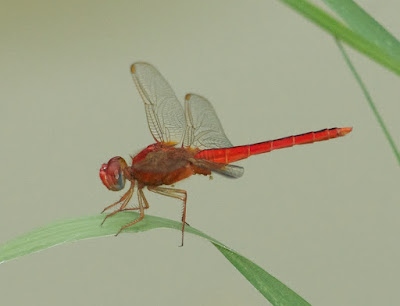







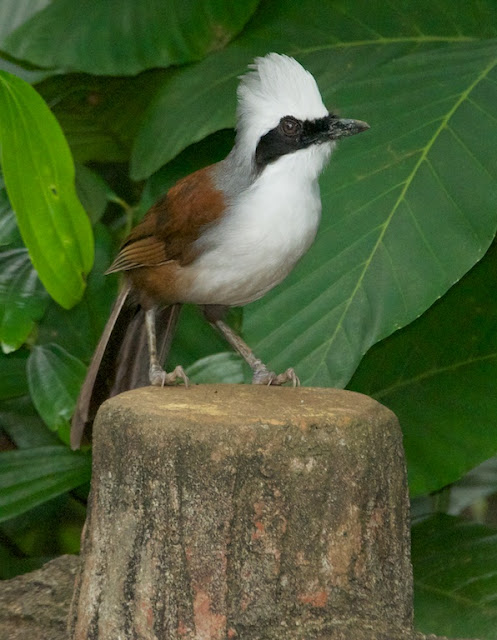






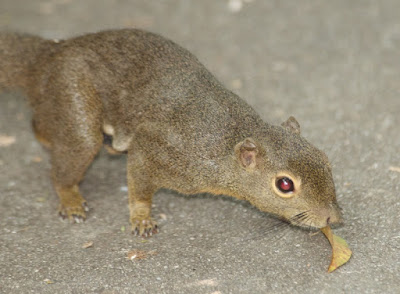




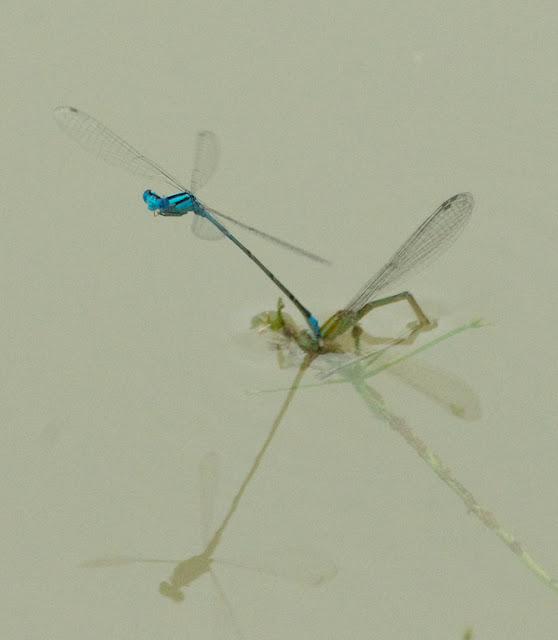






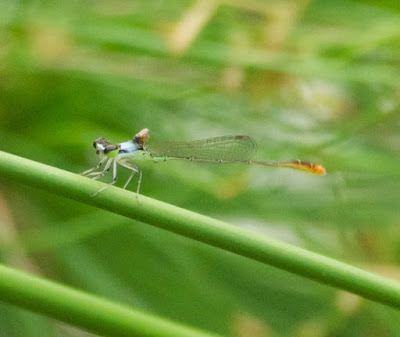









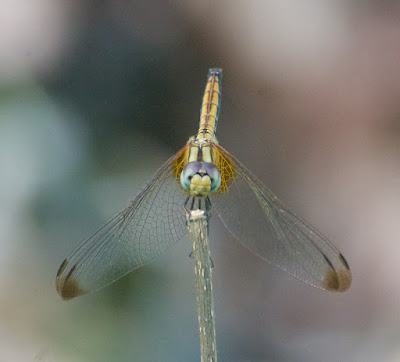
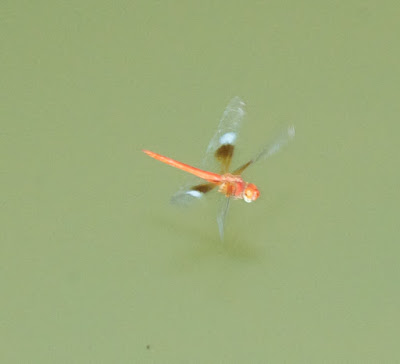




Nice blog and very informative thank you for sharing such a great blog.
ReplyDelete